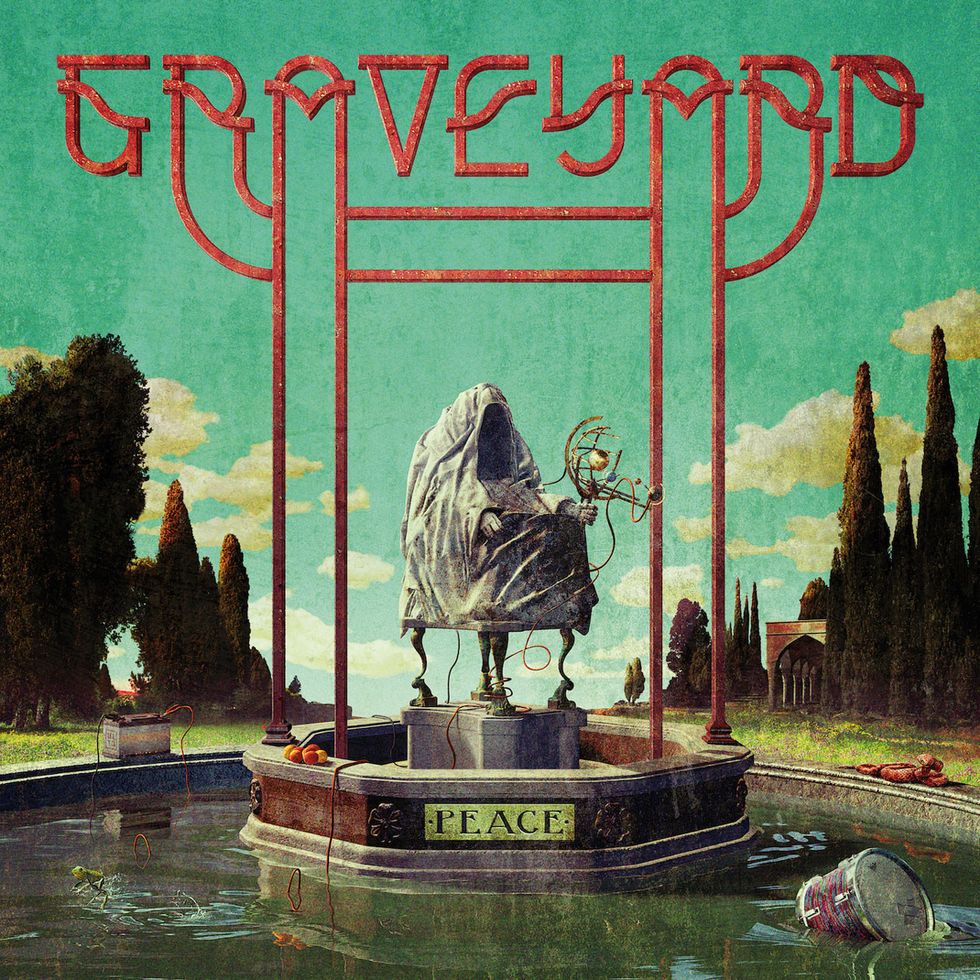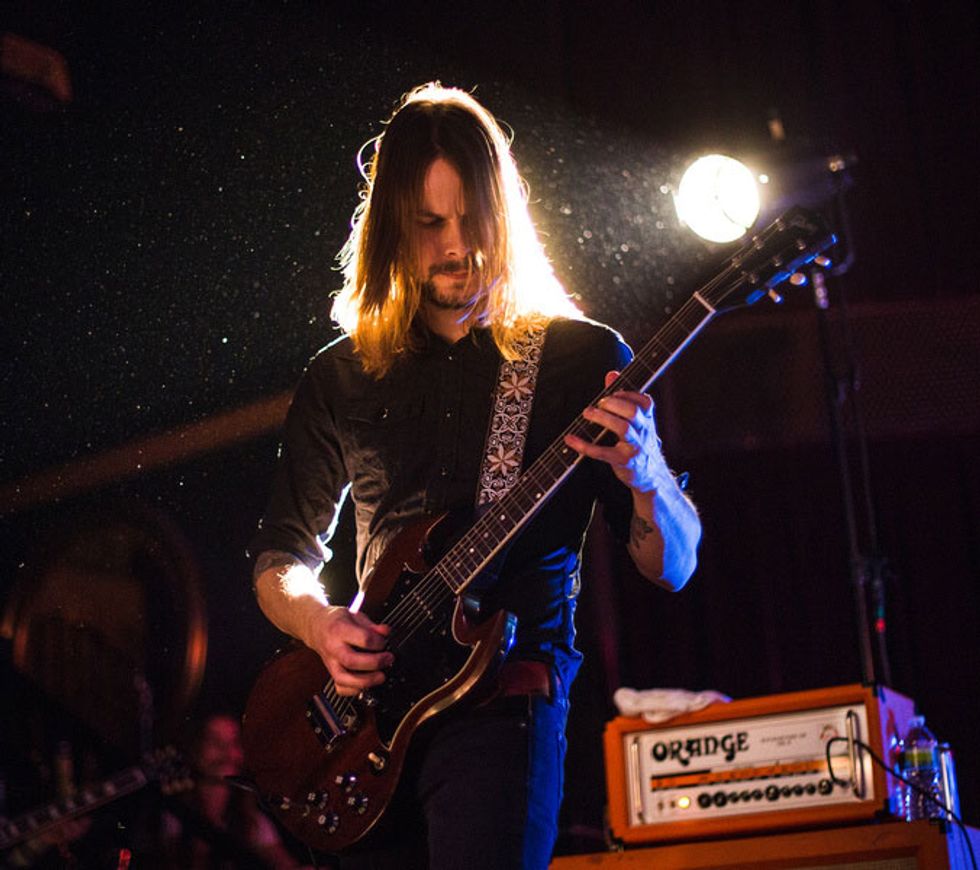Black Sabbath and Peter Green’s Fleetwood Mac may have never joined forces for a hard-hitting psychedelic mega-jam, but, thankfully, we don’t have to consider the results of that hypothetical freak-out for long because Graveyard are around to let us know how that might have sounded. With their brand of galloping rock ’n’ roll, the band swings and swaggers, wearing their influences on their sleeves. A big focus of their sound is the interplay between dueling guitarists Jonatan La Rocca Ramm and Joakim Nilsson, whose heavy unison riffage and ripping leads help the Swedish quartet sound fresh and inventive as they take on classic influences.
Formed in 2006, Graveyard released their self-titled debut album in 2007 on the Swedish prog and psych label, Transubstans, only to have it re-released a few months later by U.S.-based Tee Pee Records, home of such likeminded bands as Sleep, Earthless, and Witch. In 2011, Graveyard signed to the larger Nuclear Blast records, known for metal releases by veteran bands like Slayer and Municipal Waste. In 2016, after three albums on the label, Graveyard announced they were breaking up. That split didn’t last long: Just over a year later, Graveyard emerged with drummer Oskar Bergenheim replacing Axel Sjoberg, and declared they’d soon be releasing a new album, Peace.
While they’ve been a force to be reckoned with since the get-go, Graveyard sound bigger and badder than ever on Peace. The album is a non-stop blast of rock ’n’ roll mayhem featuring well-crafted, no-frills guitar tones that explode out of the speakers and get right to the point. Nilsson sings like a banshee over the pummeling riff of the opening track, “It Ain’t Over Yet,” with Ramm’s searing wah guitar responding at every turn. It’s off to the races from there, and songs like “Please Don’t,” “The Fox,” and “Sign of Peace” keep the thrill ride on track, while ballads “See the Day” and “Del Manic” maintain a quiet intensity that underscores the band’s psychedelic inclinations.
Premier Guitar caught up with Jonatan La Rocca Ramm to discuss what it was like getting the group back together after their time apart. Ramm also described his own experience as a player and revealed how he got his rocking tones on Peace.
In late 2016, Graveyard announced it had broken up. But before long, the band was back together and now you’re about to release Peace. What’s different about reuniting with a slightly changed lineup? And how did this affect the process of making Peace?
I think we worked the same way we had on the previous records, though we started writing songs more seriously when we got Oskar into the band. Before that, we just met up and we each had little ideas that we didn’t really know what to do with at that point, but we felt that we wanted to continue with the band and continue to play. Of course, [former drummer] Axel [Sjöberg] will be missed and it’s always sad when things like that happen, but we were going in different directions and we’re very happy to have found Oskar in this situation. Immediately it felt like he was a great fit for the band and we are back with a new energy. It’s a good group dynamic and we’re happy to be back, so it feels good.
Did the breakup alter your perspective on playing in a band?
Yeah, definitely. It becomes pretty clear that this can end any day—what you’re doing and what you take for granted. We all realized that we very much appreciate what we do and that we’re fortunate to be able to play music for a living. For a while there, we didn’t know if we were coming back at all and that wasn’t a good feeling. We missed it quite a bit. Truls [Mörck], our bass player, suggested that we should check in with Oskar, my old friend. When he came in, it felt like a fresh breeze. I think he’s a great drummer and a great person to be around, as well.
How does the writing process work for Graveyard? Is it a collective thing?
We all write songs. Sometimes we write them together and sometimes someone brings in a whole piece and we see if it’s fun to play. If it feels right, then we continue to work on the idea or just finish the song. Sometimes we jam on something and if it’s good enough, we try to develop it. Truls wrote a lot of songs for Peace—I think he wrote most of them this time.
There’s a lot of really great unison riffing and octave riffs between you and Joakim. I’m curious how you work out the guitar parts.
It just happens naturally. It starts in the practice space, when we play as a group. We’ll improvise parts and when stuff comes up we like, we try to remember it. It’s by feel, I guess.

TIDBIT: Graveyard’s fifth studio album is the first with drummer Oskar Bergenheim.
Graveyard makes musical references to bands like Black Sabbath, Led Zeppelin, and Pink Floyd—bands that have long, open, jamming sections. Onstage, you seem to keep a pretty tight rein on things, but it seems like improvisation influences your sound.
Yeah, sometimes. We might jam on something during a soundcheck and then make a song out of it. Someone starts, you know, and we just develop it. As you say, we’ve all been listening to a lot of bands where they improvise. I like that about Peter Green and Fleetwood Mac, for example. I love the jams they have on the live recordings, and all of us have always been drawn to keeping it a little free.
On Peace, your succinct solos are really effective at getting the point across and keeping things rocking. The solo on “Please Don’t” is one that stands out that way. How do you approach soloing live?
It’s always different for me. On some songs, I try to keep more to the album version, and on others I don’t at all, really. Sometimes I think, “I could do something more fun there.” For example, with “Please Don’t,” which we’ve performed a few times now, I try to keep it close to the album version. But at the end, when the solo goes down a little in volume, I’ll always do something a little different. I don’t play exactly the same—I can’t do that, really. Every song is a little different when I play it because I’ve always done that. Sometimes it’s good and sometimes it’s not. You have to gamble a bit.
Keith Richards has famously talked about how it’s important that rock ’n’ roll contains both parts—the “rock” and the “roll”—and that it needs to swing. That’s something you adhere to in Graveyard. Many of the songs on Peace swing, or even gallop, and you include lots of 6/8 and triplet rhythms. Is this a specific part of your concept?
That’s just how it comes out. I don’t think we ever had a plan about how the record would sound. We’d just focus on one song at a time and try to make it as good as possible. The gallop and the swing just come along with that. Maybe also the dynamics—take it down a notch and not have it full-on the whole time. You know, take it down and just feel it for a bit. That’s fun.
Jonatan La Rocca Ramm used to wield a Les Paul onstage, but he recently made a change. “I actually traded it for another Gibson SG Special, made one year after the one that’s my main guitar. So this second one is a ’71.” Photo by Tim Bugbee
What’s your background as a player? Where do you come from, musically speaking?
I played a lot of soccer for years when I was a kid. After having issues with my leg, I started getting interested in music. There was a big hardcore punk scene in the little city where I lived, so I got into that. The first band I joined played our version of metal or hardcore. It was very aggressive, but it was a lot of fun. Then I got into even heavier stuff—death metal and all that—and I started wondering what those bands listened to, and who inspired them. Then one day, in the car, Black Sabbath’s “The Wizard” came on the radio and I was like, “Yeah!” I’d never heard anything like it, even though my dad has always played Chuck Berry and Neil Young and stuff like that. That song made a big impression on me because then I realized I wanted to try to play like Tony Iommi. That was a big moment for me. So I got into Black Sabbath and then Zeppelin and blues rock, and after that came the blues. And I’m still stuck in that stuff, I guess. I started with punk and hardcore music and it turned into this. It has been a good journey.
What was it about Tony Iommi and Black Sabbath that struck you?
The whole band was heavy in a different way than I’d heard before. The first record has so much “roll” or swing to it. It’s still one of my favorite groups I listen to. Black Sabbath and Fleetwood Mac have made the biggest impression on me as a guitar player. That’s where I got the will to be better at guitar.
What gear are you using on Peace?
For almost the whole record I used my 1970 Gibson SG Special. It’s a wonderful guitar. I tried the Les Paul that I use live and it didn’t really do it for me in the studio. I actually traded it for another Gibson SG Special made one year after the one that’s my main guitar. So this second one is a ’71. Actually, now I have a third, so I’m quite set up right now and I feel very happy about it.
Describe the rest of your studio rig.
Well, we recorded in Park Studios in Stockholm. Stefan Boman was our engineer and Chips Kiesbye produced the record. And there was this guy, a big collector of vintage instruments and amps, who sent things to the studio because he wanted people to use them and enjoy it. So we had a bunch of amps—different amps every day. Mostly I used a Fender Blues Deluxe and a Vox AC30. One day we had a delivery of 10 or 12 amps. They were all small combos made between ’55 and ’65, and they were in mint condition. When they arrived, we’re like, “Okay, where should we start?” I think we used at least 10 of those amps on different tracks, like on solos. Every one of them sounded amazing—like a big wall of amps when you crank them up enough. I used a Gibson Maestro amp and it blew me away. They have that oil reverb, I think. It had those blue alnico Jensen speakers as well, and they sound really good. It’s amazing what they did back in those days. That was a great experience, we had a lot of fun.
You don’t normally use many pedals, right?
I didn’t use many pedals, but I had my wah pedal. It’s a Jimi Hendrix signature Dunlop wah. I also used an MXR Micro Amp a bit. Instead of adding distortion through a pedal, I like to push an amp so it has to work really hard.
What kind of amp do you use live?
I use Marshall Bluesbreakers, usually two of them. I’ve had them for a few years and they sound great. Otherwise I use whatever is there at the festival.

Guitars
1970 Gibson SG Special
1971 Gibson SG Special
Amps
Marshall 1962 Bluesbreaker (live)
Vintage Gibson Maestro (studio)
Fender Blues Deluxe (studio)
Vox AC30 (studio)
Effects
Dunlop Jimi Hendrix Cry Baby Wah
MXR Micro Amp
Strings and Picks
Ernie Ball Skinny Top/Heavy Bottom (.010–.052)
Custom 1 mm Dunlop picks
In a live setting, do you find it hard to recreate the sound of a small vintage combo that’s turned up to 10?
It’s amazing how they could accomplish that. There are a bunch of great amps today, but when you try the reissues, of course it’s not exactly the same. Even though it’s called a reissue model, they’re made so differently from the original that it’s hard to get that sound if you don’t have the real deal.I feel like I constantly search for the perfect sound live. It’s always different when you do it live, to get the same kind of bite in it. The hunt will continue forever, but I’m very happy with my setup right now.
What is the most important piece of gear for your sound?
Most precious is my SG Special—or nowadays, the three I have. It becomes your friend somehow and your tool at the same time. I wouldn’t trade my SGs, and I’ll always keep my eyes open for more of them. The thickness of the SG combined with the P-90s makes it outstanding for me.
I got a Gibson ’56 reissue Les Paul with P-90s and I thought that was going to sound even better, but I don’t know, I just went back to the SG because of its tone. I don’t know why it sounds like that. I will get as many SGs as I can. That’s all I need, I think, and a really good amp, of course. I really enjoy playing Marshall Bluesbreakers, so it’s all good now, but you can never stop keeping your eyes open for guitars and such.
A lot of American bands consider it a big deal to tour in Europe. What’s it like for you touring the U.S.?
It’s the same feeling for us. Every band that goes to the U.S. the first time thinks, “Yeah, this is it! Now we’re gonna get huge!” We were so lucky to play South by Southwest in 2008. We’ve done a bunch of tours since then and it’s always been very good for us. You guys treat us very well and somehow the tour bubble is getting even stronger. There are a lot of things to see, and there’s a big interest for music, which is great. It feels like there are a few more options in the U.S. than here with radio, which is good.
We meet a lot of people after the shows, and they seem to be genuinely interested in listening to a lot of music. Maybe Americans are more socially open than we are. Generally, I believe Swedes are a little more withdrawn or quieter. So it’s good for us to get out among Americans and share music. It’s uplifting when people really care about what they listen to.
YouTube It
In this 2018 live performance, the resurrected Graveyard revisits two songs from their earlier albums. The slow ballad “Stay For a Song,” from 2015’s Innocence & Decadence, reveals the band’s melodic side, and Jonatan La Rocca Ramm interjects sparse, bluesy leads to complement the vocal. At 3:07, things really light up as the band launches into “Ain’t Fit to Live Here,” from 2011’s Hisingen Blues. Check out the wah-soaked guitar duel between Ramm and Joakim Nilsson starting at 4:49.







![Rig Rundown: AFI [2025]](https://www.premierguitar.com/media-library/youtube.jpg?id=62064741&width=1245&height=700&quality=70&coordinates=0%2C0%2C0%2C0)












 Shop Scott's Rig
Shop Scott's Rig













 Zach loves his Sovtek Mig 60 head, which he plays through a cab he built himself at a pipe-organ shop in Denver. Every glue joint is lined with thin leather for maximum air tightness, and it’s stocked with Celestion G12M Greenback speakers.
Zach loves his Sovtek Mig 60 head, which he plays through a cab he built himself at a pipe-organ shop in Denver. Every glue joint is lined with thin leather for maximum air tightness, and it’s stocked with Celestion G12M Greenback speakers.












![Devon Eisenbarger [Katy Perry] Rig Rundown](https://www.premierguitar.com/media-library/youtube.jpg?id=61774583&width=1245&height=700&quality=70&coordinates=0%2C0%2C0%2C0)






